Contains more Mike Piazza than the Hall of Fame
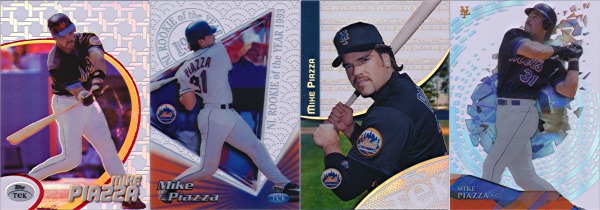 When we last checked in with Topps revivals of decades past, we saw the unenthusiastic return of Stadium Club. With a generic format, terrible photography, and no standout cards, it looked like Topps had pushed the modern-retro thing just a bit too far. After all, the Major League cards in Archives were a huge hit, Gold Label returned in a classy, though limited, form, and Finest had one of its best designs in more than 20 years. Stadium Club seemed to show that Topps was out of ideas, but they didn’t stop there. Topps dug back into the turn of the century well for one of its shortest-lived but fondest-remembered experiments: Tek.
When we last checked in with Topps revivals of decades past, we saw the unenthusiastic return of Stadium Club. With a generic format, terrible photography, and no standout cards, it looked like Topps had pushed the modern-retro thing just a bit too far. After all, the Major League cards in Archives were a huge hit, Gold Label returned in a classy, though limited, form, and Finest had one of its best designs in more than 20 years. Stadium Club seemed to show that Topps was out of ideas, but they didn’t stop there. Topps dug back into the turn of the century well for one of its shortest-lived but fondest-remembered experiments: Tek.
Topps Tek ran from just 1998 to 2000. In a departure from cardboard, Tek is an all-acetate product. Plastic cards? It’s an interesting novelty, but it wouldn’t last. The product’s unique hook was that each player is featured on a variety of different patterned backgrounds. The 1998 version, which featured John Olerud and Mike Piazza as Mets, had 90 different patterns for each player. The 1999 version (with Piazza), cut that to 30 but had two photograph variants for each player. 2000 (again Piazza) narrowed the checklist even more with just 20 different patterns, five each with four different photographs, the last five being colored pattern short prints. Tek was tailor-made for player collectors and made base cards relevant again. And then it was gone. The rise of autographs and memorabilia and the eventual emergence of parallels pushed quirky concepts like Tek aside. Those player sets were fun to chase but almost impossible to finish. Tek was a journey. 14 years later, the journey begins anew.
Card Design
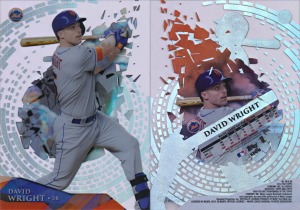 The design is unquestionably Tek. Asymmetric with an opaque central element, a small piece on the bottom, and a big player photograph over a pattern. The shattered ball in the middle is interesting, but the lack of color on the front doesn’t really do it for me. But there’s a lot more to see here.
The design is unquestionably Tek. Asymmetric with an opaque central element, a small piece on the bottom, and a big player photograph over a pattern. The shattered ball in the middle is interesting, but the lack of color on the front doesn’t really do it for me. But there’s a lot more to see here.
Patterns
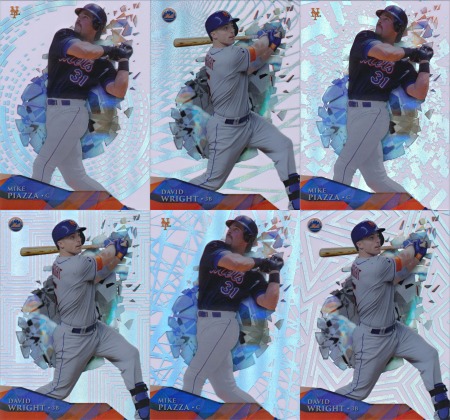 No Tek release would be complete without Mike Piazza, so he joins Wright in the base set. 2014 High Tek features 12 different patterns, but each player only has 6 (6 are for the NL and the AL gets a different 6). That’s a bit of a departure from even the modest variety in 2000 Tek and a far cry from 1998’s 90 different patterns. Also unlike the previous incarnations, 2014 High Tek’s patterns aren’t numbered and all have different (unpublished) insertion ratios. I am not a fan of this approach. Personally, I think the approach taken in 2000 would have been a better way to go, only with 18 total patterns so the set would display well in binder pages.
No Tek release would be complete without Mike Piazza, so he joins Wright in the base set. 2014 High Tek features 12 different patterns, but each player only has 6 (6 are for the NL and the AL gets a different 6). That’s a bit of a departure from even the modest variety in 2000 Tek and a far cry from 1998’s 90 different patterns. Also unlike the previous incarnations, 2014 High Tek’s patterns aren’t numbered and all have different (unpublished) insertion ratios. I am not a fan of this approach. Personally, I think the approach taken in 2000 would have been a better way to go, only with 18 total patterns so the set would display well in binder pages.
Diffractors
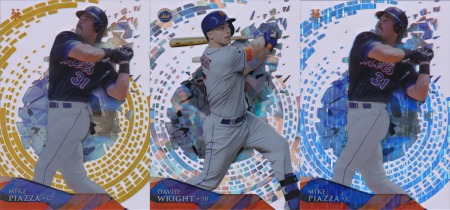 Of course, this being 2014, the variants couldn’t stop there. The base pattern of each player has several serial numbered diffractor parallels, starting with gold (numbered to 99), ice (numbered to 75), disco (numbered to 50), clouds (numbered to 25), black and white image (numbered to 15), and so on. There’s no real color until you get the 10 and under level, which also features a set of 1/1 printing proofs (not plates), some of which have more than one copy. No color in the patterns, no color in any of the common parallels? It all makes for a rather dull display.
Of course, this being 2014, the variants couldn’t stop there. The base pattern of each player has several serial numbered diffractor parallels, starting with gold (numbered to 99), ice (numbered to 75), disco (numbered to 50), clouds (numbered to 25), black and white image (numbered to 15), and so on. There’s no real color until you get the 10 and under level, which also features a set of 1/1 printing proofs (not plates), some of which have more than one copy. No color in the patterns, no color in any of the common parallels? It all makes for a rather dull display.
Inserts
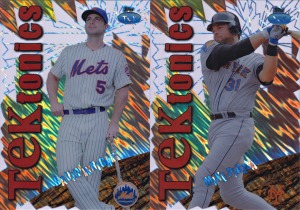 The classic TEKtonics and TEKnicians are back here, plus Low Tek. All are numbered to 50 and some have autographed parallels numbered to 10 or 15. Piazza and Wright are featured in the TEKtonics set.
The classic TEKtonics and TEKnicians are back here, plus Low Tek. All are numbered to 50 and some have autographed parallels numbered to 10 or 15. Piazza and Wright are featured in the TEKtonics set.
Autographs
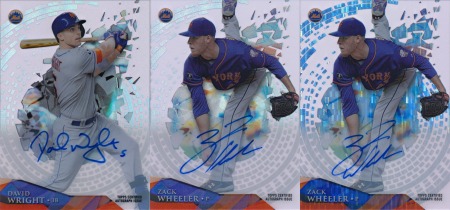 And of course we have to have autographs. Wright and Piazza are in here too, plus Zack Wheeler. Parallels include all of the standard diffractor parallels except gold and ice. Wright also has a TEKtonics autograph while Piazza has a variety of buyback autographs. It’s nice to see more Piazza autographs in circulation and the Wright and Wheeler autos could be picked up pretty cheap. That’s a bit of a problem though.
And of course we have to have autographs. Wright and Piazza are in here too, plus Zack Wheeler. Parallels include all of the standard diffractor parallels except gold and ice. Wright also has a TEKtonics autograph while Piazza has a variety of buyback autographs. It’s nice to see more Piazza autographs in circulation and the Wright and Wheeler autos could be picked up pretty cheap. That’s a bit of a problem though.
Box Format
2014 High Tek was released as a high-end product with just one pack of eight cards per box with one autograph in every pack. For a product that was built on the variety of base cards, this release format makes no sense. This format only appeals to autograph speculators, not the player collectors who should be driving sales. The whole structure of the product, with tiered patterns and lots of numbered parallels, just doesn’t fit with what the old Tek brand was about.
The Verdict
It’s nice to see one of the more unique products from the age of cardboard (and cardboardless) experimentation back with a new generation of players. There’s a lot to like here and there’s not much else like it on the market. Scratching is always a problem with acetate, but if you can look past that, there are some interesting player sets to be built here. They just aren’t as interesting as they could be. Topps did this one halfway, playing it safe with autographs and parallels to drive a high price point with few base cards. That might work with something like Bowman Sterling, which is all about the autographs, but it feels forced and unnecessary here. Do we really need guaranteed hits in a product like this? Can’t we just enjoy a variety of unique base cards?
Comments are closed.